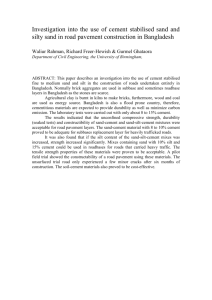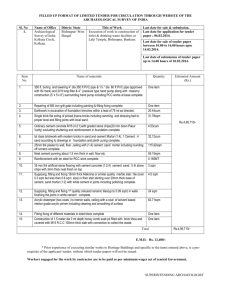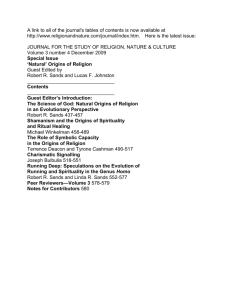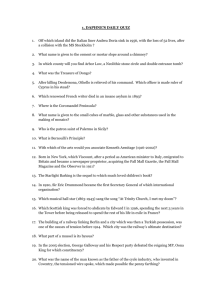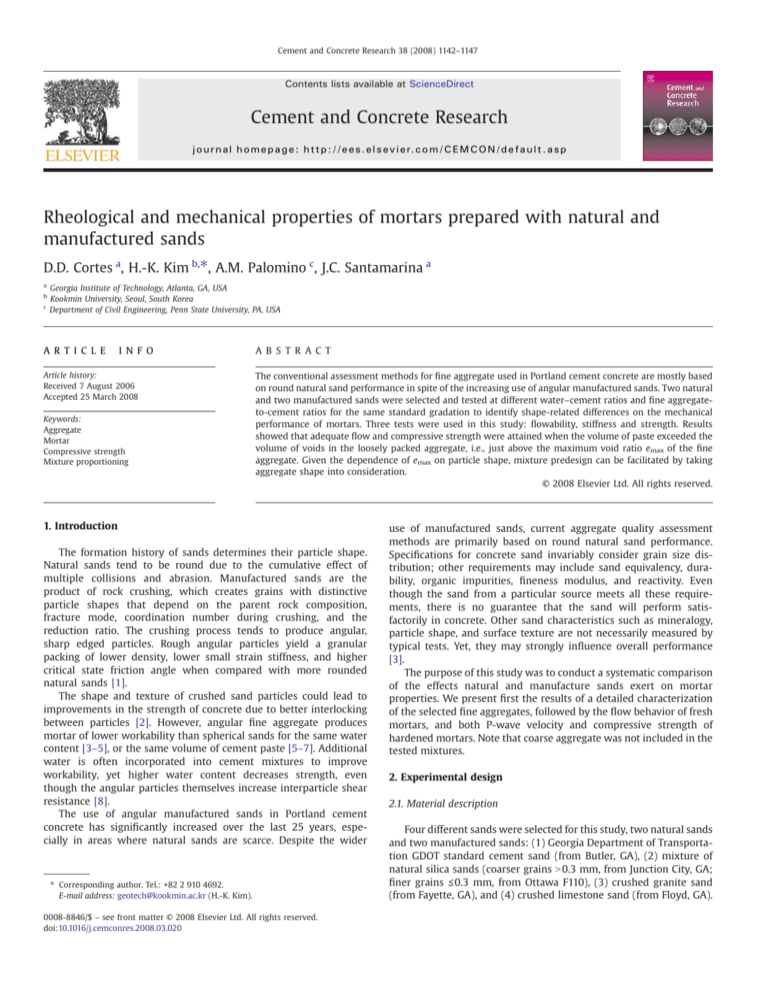
Cement and Concrete Research 38 (2008) 1142–1147
Contents lists available at ScienceDirect
Cement and Concrete Research
j o u r n a l h o m e p a g e : h t t p : / / e e s. e l s ev i e r. c o m / C E M C O N / d e f a u l t . a s p
Rheological and mechanical properties of mortars prepared with natural and
manufactured sands
D.D. Cortes a, H.-K. Kim b,⁎, A.M. Palomino c, J.C. Santamarina a
a
b
c
Georgia Institute of Technology, Atlanta, GA, USA
Kookmin University, Seoul, South Korea
Department of Civil Engineering, Penn State University, PA, USA
A R T I C L E
I N F O
Article history:
Received 7 August 2006
Accepted 25 March 2008
Keywords:
Aggregate
Mortar
Compressive strength
Mixture proportioning
A B S T R A C T
The conventional assessment methods for fine aggregate used in Portland cement concrete are mostly based
on round natural sand performance in spite of the increasing use of angular manufactured sands. Two natural
and two manufactured sands were selected and tested at different water–cement ratios and fine aggregateto-cement ratios for the same standard gradation to identify shape-related differences on the mechanical
performance of mortars. Three tests were used in this study: flowability, stiffness and strength. Results
showed that adequate flow and compressive strength were attained when the volume of paste exceeded the
volume of voids in the loosely packed aggregate, i.e., just above the maximum void ratio emax of the fine
aggregate. Given the dependence of emax on particle shape, mixture predesign can be facilitated by taking
aggregate shape into consideration.
© 2008 Elsevier Ltd. All rights reserved.
1. Introduction
The formation history of sands determines their particle shape.
Natural sands tend to be round due to the cumulative effect of
multiple collisions and abrasion. Manufactured sands are the
product of rock crushing, which creates grains with distinctive
particle shapes that depend on the parent rock composition,
fracture mode, coordination number during crushing, and the
reduction ratio. The crushing process tends to produce angular,
sharp edged particles. Rough angular particles yield a granular
packing of lower density, lower small strain stiffness, and higher
critical state friction angle when compared with more rounded
natural sands [1].
The shape and texture of crushed sand particles could lead to
improvements in the strength of concrete due to better interlocking
between particles [2]. However, angular fine aggregate produces
mortar of lower workability than spherical sands for the same water
content [3–5], or the same volume of cement paste [5–7]. Additional
water is often incorporated into cement mixtures to improve
workability, yet higher water content decreases strength, even
though the angular particles themselves increase interparticle shear
resistance [8].
The use of angular manufactured sands in Portland cement
concrete has significantly increased over the last 25 years, especially in areas where natural sands are scarce. Despite the wider
⁎ Corresponding author. Tel.: +82 2 910 4692.
E-mail address: geotech@kookmin.ac.kr (H.-K. Kim).
0008-8846/$ – see front matter © 2008 Elsevier Ltd. All rights reserved.
doi:10.1016/j.cemconres.2008.03.020
use of manufactured sands, current aggregate quality assessment
methods are primarily based on round natural sand performance.
Specifications for concrete sand invariably consider grain size distribution; other requirements may include sand equivalency, durability, organic impurities, fineness modulus, and reactivity. Even
though the sand from a particular source meets all these requirements, there is no guarantee that the sand will perform satisfactorily in concrete. Other sand characteristics such as mineralogy,
particle shape, and surface texture are not necessarily measured by
typical tests. Yet, they may strongly influence overall performance
[3].
The purpose of this study was to conduct a systematic comparison
of the effects natural and manufacture sands exert on mortar
properties. We present first the results of a detailed characterization
of the selected fine aggregates, followed by the flow behavior of fresh
mortars, and both P-wave velocity and compressive strength of
hardened mortars. Note that coarse aggregate was not included in the
tested mixtures.
2. Experimental design
2.1. Material description
Four different sands were selected for this study, two natural sands
and two manufactured sands: (1) Georgia Department of Transportation GDOT standard cement sand (from Butler, GA), (2) mixture of
natural silica sands (coarser grains N0.3 mm, from Junction City, GA;
finer grains ≤0.3 mm, from Ottawa F110), (3) crushed granite sand
(from Fayette, GA), and (4) crushed limestone sand (from Floyd, GA).
D.D. Cortes et al. / Cement and Concrete Research 38 (2008) 1142–1147
The four sands were sieved to obtain the same grain size distribution
shown as a dotted line in Fig. 1. The recommended grain size
distribution range for the standard concrete sand – 10NS of the GDOT
supplemental specification section 801 – is represented by the shaded
area in Fig. 1. Measured index properties of the tested sands are
summarized in Table 1.
Quartz is the prevailing mineral in both natural sands (more
than 99% by mass). The crushed granite sand consists of ~90%
quartz or feldspar minerals (microcline, plagioclase) and ~5–10%
mica (biotite, muscovite) by mass. These mica particles are smaller
than 300 mm in size. The crushed limestone sand is mostly CaCO3
(hardness index 3).
The roundness and sphericity of 90 sand grains were measured for
each sand using optical microscopy (Leica M26 Stereomicrosope) and
the Krumbein and Sloss classification chart [9]. Selected images are
assembled in Fig. 2. The shape factors for mean size D50 particles of all
observed sands fell within a narrow range (Table 1); the finer D90
particles were distinctively more angular and platier in manufactured
sands than in natural sands. Furthermore, optical microscopy images
revealed that crushed granite sand had sharper edges than crushed
limestone sand.
The angle of repose was obtained from side-view digital images of
sand piles, while the maximum and minimum void ratios emax and
emin were determined following standard ASTM procedures [10,11].
1143
Table 1
Engineering properties of tested sands
Sand
Sphericity
Roundness
emax
emin
Angle of repose
GDOT standard
Mixed natural
Crushed granite
Crushed limestone
0.71
0.71
0.62
0.64
0.39
0.42
0.27
0.33
0.73
0.72
0.75
0.77
0.43
0.43
0.43
0.44
36°
35°
38°
37°
Note: The shape parameters are based on measurements of 90 grains. The variation in
sphericity and roundness is about ±0.15.
during 25 drops. The physical meaning of the flow test was previously
reported by the authors [13].
Each mortar batch provided enough material for three cubical
specimens. Cubes were prepared by filling the cubical molds with two
layers and tamping 32 times per layer, and cured in airtight containers
for seven days, as described in the ASTM standard [14]. The P-wave
velocity of the seven-day cured specimens was determined using Pwave piezocrystals (MATEC CSO.0510, 50 kHz) and peripheral
electronics. Finally, the unconfined compressive strength was measured by recording the applied peak axial force during uniaxial
compression of the mortar cubes.
3. Experimental results
2.2. Test procedures
3.1. Fresh mortar flowability
A total of 64 mortar batches (Portland cement type I–II, water, and
fine aggregate) were prepared by mixing each of the four sand
specimens at four water–cement ratios: w/c = 0.42, 0.46, 0.50, and
0.54, and at four fine aggregate to cement ratios: FA/c = 2.00, 2.75, 3.25,
and 4.00. Mass-blending fractions for all mixes are shown in Table 2.
Admixtures were not incorporated.
Three tests were conducted for each mixture. The flow test was run
on the fresh mortar. Small-strain P-wave velocity and large-strain
unconfined compressive strength were run on seven-day hardened
mortar cubes.
The flow test was performed following the ASTM standard [12]. A
cone-shaped mold was placed on the center of a vibrating table and
filled with freshly mixed hydraulic cement mortar in two lifts. When
the mold was removed, the vibrating table was dropped 25 times in
15 s. Flow is the percentage increase in mortar diameter. We captured
the horizontal spread of the mortar pile using digital photography
Images of mortar spread after 25 drops are presented in a mosaic
format that parallels the test matrix (Fig. 3). The case shown in Fig. 3
corresponds to mixtures prepared with the GDOT standard sand.
“Wet-flow” is herein used to designate mortars that show a
continuous slurry surface. In contrast, “dry-flow” designates mortars
that break and spread in granulated form. Table 3 summarizes the
flow data for all mixtures following a table organization that parallels
the picture mosaic in Fig. 3. The boundary that separates the visual
distinction between wet-flow (shaded cells in Table 3) and dry-flow is
shown in each case. Clearly, mixtures exhibited wet-flow when w/c
was high and FA//c was low. Note that a large flow radius was also
obtained with high FA//c and low w/c mixtures under dry-flow
conditions.
3.2. Small strain P-wave velocity
Table 4 summarizes the mean P-wave velocity for the specimens
prepared with each mixture. At low w/c and FA//c ≥ 2.75, the measured
mortar mixture P-wave velocity varied significantly with aggregate
type, i.e. natural and manufactured sands. However, when w/c was
high and FA//c was low, the difference in the P-wave velocity became
less pronounced. Specimens with internal heterogeneity can yield
poor first arrivals due to multiple travel paths, and the measured Pwave velocities are less reliable; such cases are denoted with an
asterisk in Table 4: they fall in the dry-flow region, i.e., more difficult to
compaction.
3.3. Unconfined compressive strength
Unconfined compressive strength data are summarized versus FA/c
and w/c for all sands in Table 5. Higher strength values were measured
on specimens that exhibited wet-flow conditions.
3.4. General observations
Fig. 1. Grain size distribution of selected sands. (The dotted line is the same for the four
tested sands.) The shaded area represents the GDOT target band for standard concrete
sand (10NS).
Flow, P-wave velocity and compressive strength trends can be
misleading when the data in Tables 3, 4 or 5 are plotted versus either
FA//c or w/c because trends reverse across the dry-flow to wet-flow
1144
D.D. Cortes et al. / Cement and Concrete Research 38 (2008) 1142–1147
Fig. 2. Optical microscopy pictures of sand particles. The length of white segments is 0.5 mm in all pictures.
transition. A detailed volumetric–mechanical interpretation is
attempted next.
4. Analysis and discussion
4.1. Particle shape and packing density
Sphericity and roundness reveal aspects of the particle formation
history and play a major role in determining the bulk behavior of the
aggregate. Shape irregularities limit particle mobility and their ability
to attain minimum potential energy in tightly packed configurations.
As a result, the maximum void ratio, emax, the minimum void ratio,
emin, and the difference Ie = emax − emin increase as the particles become
more angular and irregular. While the tested sands comprised a
limited range in particle shape, results in Table 1 are in agreement
with published trends [1], and differences in frictional resistance and
packing density among the sands reflect differences in particle shape.
4.2. Flow and volume fraction of paste VP/VFA
The transition from dry-flow to wet-flow can be analyzed in terms
of the ratio between the volume of cement paste VP and the volume of
solids in the fine aggregate VFA. The volume fraction VP/VFA can be
expressed in terms of the specific gravity G, unit weight γ, and the
weight W of each component:
Wc
Ww
VP
ðVc þ Vw Þ gw Gc þ gw
Wc ð1=Gc þ w=cÞ
¼
¼
¼
WFA
VFA
WFA =GFA
VFA
g G
w
FA
GFA ð1=Gc þ w=cÞ
¼
ðFA=cÞ
ð1Þ
where the subscripts stand for w: water, c: cement, and FA: fine
aggregate. The ratio w/c is water–cement ratio, and FA/c is fine
aggregate to cement ratio.
Flow is plotted versus VP/VFA in Fig. 4 (GFA = 2.6 ~ 2.7, measured for
each sand; Gc = 3.12). Mixtures that exhibit wet-flow conditions are
identified as encircled points. Under saturated conditions (approximation in wet-flow mixtures), the volume fraction VP/VFA is
equivalent to the void ratio in the fine aggregate. For comparison,
we identify the two extreme void ratios emax and emin for each sand in
Fig. 4. It can be concluded that wet-flow is attained when sufficient
paste is available to separate the grains beyond the loosest packing
density of the sand emax so that the interaction between sand grains is
minimized. A graphical interpretation is presented in Fig. 5.
Results in Fig. 4 suggest a minimum amount of paste VP/VFA = 1.1 ±
0.05 emax to attain wet-flow in specimens prepared with either
natural or manufactured sands. As manufactured sands pack at higher
values of emax, more paste will be required for manufactured sand
mortars to attain the same flowability as the natural sand mortars.
4.3. Flow and strength
Strength data are plotted versus flow in Fig. 6, where wet-flow
mixtures are distinguished by encircling data points. In the dry-flow
regime, mortar spreads in granulated form, without conserving
volume; spreading increases at low VP/VFA. Capillary forces hinder
densification and together with the insufficient volume of paste
result in air pockets inside the hardened mortar, and reduced
strength. Thus, there is negative correlation between measured flow
values and the corresponding compressive strengths for all dry-flow
mixtures (Fig. 6).
In the wet-flow regime (VP/VFA N ~ 1.1 emax), the mortar compressive
strength is controlled by the water–cement ratio of the paste (Fig. 6). A
positive correlation between flow and strength is observed only in a
narrow range of FA/c near the transition from dry-flow to wet-flow
(Fig. 6). Strength may decrease in high flow mixtures at high VP/VFA.
The envelopes sketched on Fig. 6 capture these observations.
4.4. Strength and stiffness
P-wave velocity is plotted versus compressive strength in Fig. 7
(Note: similar trends were found in previous studies [15,16]).
Table 2
Tested mortars — identical ratios are used with each of the four fine aggregates
Batch ID
1
2
3
4
5
6
7
8
9
10
11
12
13
14
15
16
Water [%]
Cement [%]
Aggregate [%]
12.3
29.2
58.5
13.3
28.9
57.8
14.3
28.6
57.1
15.3
28.2
56.5
10.1
24.0
65.9
10.9
23.8
65.3
11.8
23.5
64.7
12.6
23.3
64.1
9.0
21.4
69.6
9.8
21.2
69.0
10.5
21.1
68.4
11.3
20.9
67.8
7.7
18.5
73.8
8.4
18.3
73.3
9.1
18.2
72.7
9.7
18.1
72.2
Note: Values are mass fractions.
D.D. Cortes et al. / Cement and Concrete Research 38 (2008) 1142–1147
1145
Table 4
P-wave velocity: The effect of fine aggregate-to-cement FA/c and water-to-cement w/c
ratios
w/c ratios
on the
on the
small-strain
small-strain
stiffness
stiffness
of 7-day
of 7-day
cured
cured
mortars
mortars
Fig. 3. Flow at 25 drops. These mortars are prepared with Georgia DOT standard
concrete sand. The dotted line indicates the boundary between “wet-flow” and
“dry-flow”.
Velocity and strength are positively correlated when the compressive strength is below ~15 MPa (only dry-flow mixtures are found
in this region). Thereafter, the volume fraction of paste VP/VFA and
the w/c ratio have a pronounced effect on strength, as they control
porosity and pore size distribution. However, VP/VFA, w/c or even
sand type (shape and mineralogy) have almost no affect on the Pwave velocity of hardened wet-flow mixtures within the resolution
of the gathered data (Fig. 7); apparently, the properties of fine
aggregates are concealed by the properties of the paste that fills
Note:
indicates weak
weak first
firstarrivals.
arrivals.Values
ValuesofofP-wave
P-wavevelocity
velocityare
areexpressed
expressed
Note: The asterisk indicates
in km/s.
the voids, and the asymptotic P-wave velocity is determined by
the mortar.
5. Conclusions
We implemented a comprehensive experimental study of mortars prepared with two round natural sands and two angular
Table 3
Flow: The effect of fine aggregate-to-cement FA/c and water–cement
water–cement w/c
w/c ratios
ratios on
on
fresh mortar flowability
Flow F is defined as F = (R25
− R00) / R00 × 100[%], where R25
is the radius of the mortar pile
25
25
after the 25th drop and R0 is the initial radius of the mortar pile (ASTM C 1437 2001).
Table 5
Unconfined compressive strength: The effect of fine
fine aggregate-to-cement
aggregate-to-cement FA/c
FA/c and
and
water–cement w/c ratios on uniaxial
uniaxial compression
compression strength
strength of
of 7-day
7-daycured
curedmortars
mortars
Values of compressive strength expressed in MPa.
1146
D.D. Cortes et al. / Cement and Concrete Research 38 (2008) 1142–1147
Fig. 4. Flow vs. relative volume of cement paste VP/VFA. Wetness is visually assessed from digital image mosaics similar to the one shown in Fig. 3. The arrows indicate the boundary
between dry-flow and wet-flow. Encircled data points indicate specimens that exhibit wet-flow.
manufactured sands, at various water–cement and fine aggregate-tocement ratios to evaluate the roles of particle shape on flow, P-wave
velocity, and unconfined compressive strength. Conclusions follow:
• Mortars exhibit “wet-flow” (i.e., keep a continuous slurry-type
surface while flowing) when the volume of paste VP is greater than
the volume of voids within the loosely packed fine aggregate VFA.
The boundary is found at VP/VFA N ~ 1.1 emax in the tested sands.
• Flow and the volume fraction of cement paste VP /VFA are negatively
correlated in the dry-flow regime (VP/VFA b ~ 1.1 emax) as mortars
spread in granular form. The positive correlation between flow and
VP/VFA in wet-flow mixtures (VP/VFA N ~ 1.1 emax) reflects reduced
interaction between sand grains.
• The unconfined compressive strength and flow are positively
correlated near the VP/VFA N ~1.1 emax transition. Thereafter, strength
reaches an asymptote value or may even decrease at high paste
volume fraction. The asymptotic strength depends on the paste w/c,
rather than on the type of fine aggregate.
• The small-strain stiffness of hardened wet-flow mortars is controlled by the paste stiffness, as the paste fills the voids and conceals
the properties of grains (shape and mineralogy) on small-strain
measurements.
• The loosest packing density of the fine aggregate emax depends on
particle shape. Therefore, a larger volume of paste will be required to
attain adequate flowability and strength when angular crushed fine
aggregates are used instead of natural round aggregates of the same
grain size distribution.
Acknowledgements
This research was supported by a grant from the Georgia
Department of Transportation and the Georgia Construction
Fig. 5. Volume fraction between the volume of cement paste VP and the volume of solids in the fine aggregate VFA.
D.D. Cortes et al. / Cement and Concrete Research 38 (2008) 1142–1147
Fig. 6. Fresh mortar flow vs. 7-day compressive strength for all tested sands. Encircled
data points indicate specimens that exhibit wet-flow.
Aggregate Association (GCAA). Additional support was provided by
the Goizueta Foundation.
References
[1] G.C. Cho, J.S. Dodds, J.C. Santamarina, Particle shape effects on packing density,
stiffness and strength — natural and crushed sands, ASCE Journal of Geotechnical
and Geoenvironmental Engineering 132 (5) (2006) 591–602.
[2] H. Donza, O. Cabrera, E.F. Irassar, High-strength concrete with different fine
aggregate, Cement and Concrete Research 32 (11) (2002) 1755–1761.
[3] P. Quiroga, D. Fowler, The effects of aggregates characteristics on the performance
of portland cement concrete, International Center for Aggregates Research 104-1F
(2004) 358.
[4] S. Jamkar, C. Rao, Index of aggregate particle shape and texture of coarse aggregate
as a parameter for concrete mix proportioning, Cement and Concrete Research 34
(11) (2004) 2021–2027.
[5] M. Westerholm, Rheology of the mortar phase of concrete with crushed aggregate,
Department of Chemical Engineering and Geosciences, Licentiate, vol. 198, Luleå
University of Technology, Stockholm, 2006.
[6] F.I. Mel'nikov, Use of calculation methods for determining compositions of
refractory concretes, Refractories and Industrial Ceramics 11 (1970) 591–595.
1147
Fig. 7. Compressive strength versus P-wave velocity (7-day cured cement mortars).
Encircled data points indicate specimens that exhibit wet-flow.
[7] H. Järvenpää, Quality characteristics of fine aggregates and controlling their effects
on concrete, Department of Materials Science and Rock Engineering, Helsinki
University of Technology, Doctor of Technology, vol. 243, 2001.
[8] M.F. Kaplan, Flexural and compressive strength of concrete as affected by the
properties of coarse aggregates, American Concrete Institute 55 (1959) 1193–1208.
[9] W.C. Krumbein, L.L. Sloss, Stratigraphy and sedimentation, W.H. Freeman and
Company, San Francisco, 1963, p. 497.
[10] ASTM D 4253-00 “Standard Test Methods for Maximum Index Density and Unit
Weight of Soils Using a Vibratory Table.” American Society for Testing and
Materials.
[11] ASTM D 4254-00 “Standard Test Methods for Minimum Index Density and Unit
Weight of Soils and Calculation of Relative Density.” American Society for Testing
and Materials.
[12] ASTM C1437-01 “Standard Test Method for Flow of Hydraulic Cement Mortar.”
American Society for Testing and Materials.
[13] H.K. Kim, D.D. Cortes, J.C. Santamarina, Flow test: particle-level and macroscale
analyses, ACI Materials Journal 104 (3) (2007) 323–327.
[14] ASTM C 109 “Standard Test Method for Compressive Strength of Hydraulic Cement
Mortars.” American Society for Testing and Materials.
[15] R. Jones, E.N. Gatfield, Testing concrete by an ultrasonic pulse technique, Road
Research Technical 34 (1955) 48.
[16] D.F. Orchard, Concrete Technology, Applied Science Publisher Ltd., London, 1979,
p. 375.

